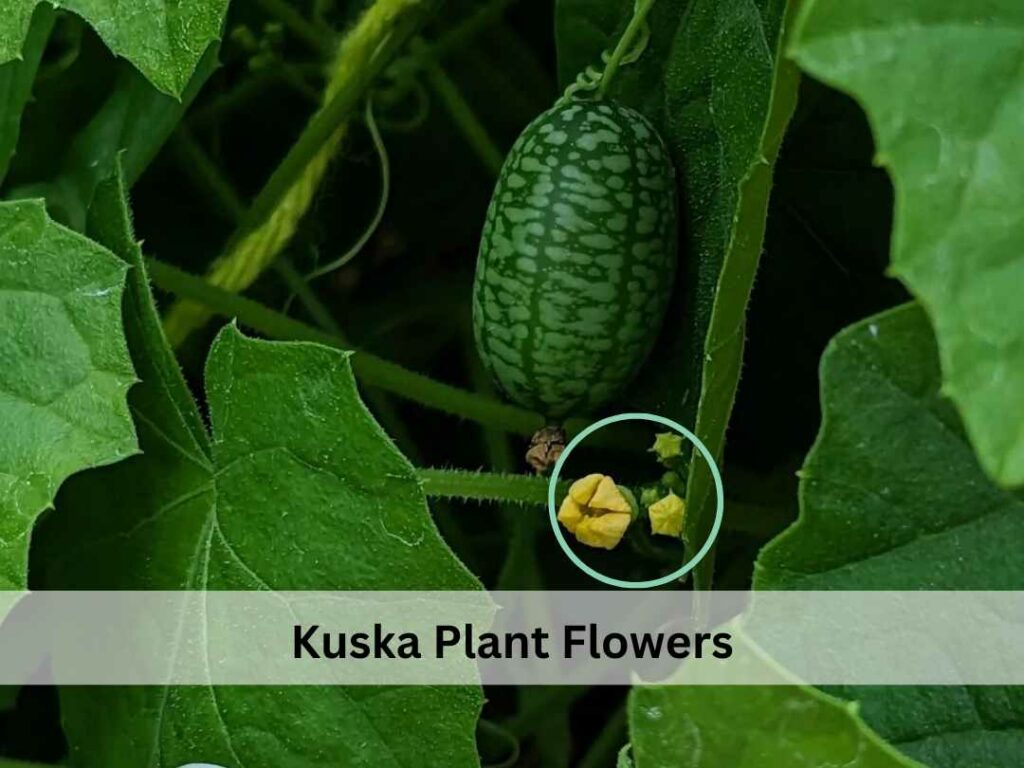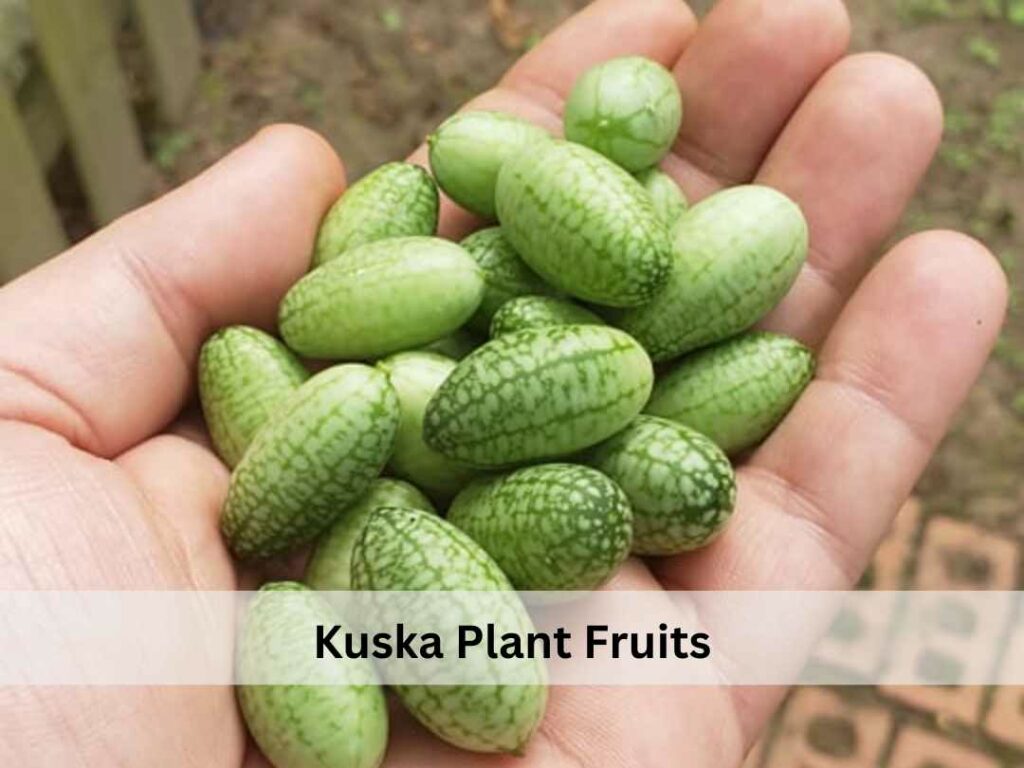Kuska Plant is a very unique highly productive, easy-to-grow vegetable plant belonging to family cucurbitaceae. It is vining species with the height of 2.5-3 m. Although its Perennial species it is grown as annual due to its sensitivity to frost. It is botanically called Melothria scabra and it has got many other common names namely: Mouse melon, Cucamelon, Mexican miniature watermelon, Mexican sour gherkin, and Mexican sour cucumber.
Common name Mexican miniature watermelon and mouse melon comes from its grape -sized fruits developing from yellow flowers. It is called Cucamelon because it’s the progeny of cucumber and watermelon and tastes like mixture of both. Common name Mexican sour gherkin and Mexican sour cucumber came from its sour taste.
It is grown for its tiny grape-sized edible fruit and tastes like cucumbers with sour note.
It is native to Mexico & Central America and found to have grown commonly for household consumption and farmers markets. It is rarely found in commercial mainstream because its benefits are yet to be explored by many gardeners and commercial farmers.
Leaves

Kuska plant bears Palmate leaves like regular cucumber plant. There are 3-5 Lobes in its leaves with length & width of 3-7cm. Upper leaf surface is covered with small hairs called trichrome making it scabrous.
Flowers

It bears solitary small & yellow flowers with 5 petals and 4mm diameter. Unlike other cucurbits it bears female flower before male flower which is unusual for cucurbits. Monoecious and bear male and female flower on the same plant.
Fruits

The fruit of Kuska plant is quite interesting. It bears grapes sized miniature watermelon like fruit with length = 2.5-4cm and W=18-9.6cm resulting into olive shape. Fruit is mainly green with dark green stripes.
Talking about flavor it tastes like normal cucumber with sour note. Fruits are tiny, juicy, and edible and are packed with vitamins and antioxidants.
Toxicity
As it is not toxic to pets and holds numerous health benefits to humans it is best idea to add this plant to your kitchen garden.
USDA Growing Zone:
USDA hardiness of Zone 9-10 is suitable for growing Cucamelons as perennials and 4-10 for growing Cucamelons as annuals with adjustments in planting and growing patterns.
In warmer zones; 9-10 they have option to be directly sown outdoors after last frost date or grown as perennials. In these regions Kuska plant can thrive mild winter and cold climate.
In cooler zones; 4-8 they cannot thrive frost so they need to be germinated indoors before 4-6 weeks of last expected frost date and transplanted outdoors in following spring. Since Kuska plant require hot tropical climate for its optimal growth adjusting climate and growing pattern in cooler regions will be challenging and must.
Taxonomic Classification
| Kingdom | Plantae |
| Clade | Tracheophytes |
| Clade | Angiosperms |
| Clade | Eudicots |
| Order | Cucurbitales |
| Family | Cucurbitaceae |
| Genus | Melothria |
| Species | M.scabra |
Care and Management
The quick overview for care and management of Kuska plant is tabulated below:
| Light | 6-8 hours of direct sunlight |
| Temperature | 18-23 °C (65-75 °F) |
| Soil | Well-drained ,Slightly acidic and rich in organic matter pH ranging from 6.1-6.8 |
| Water | At least one inch of water weekly |
| Humidity | High humidity i.e. 60-80% |
| Fertilizers | Fertilize with starter fertilizer solution after 3-4 weeks of germination |
| Spacing | 9-12 inches |
| Pruning | Pinch the growing tips in summer and winter after height of 8 feet. |
The detailed explanation of care and management of Kuska plant is:
Light
Kuska plant needs full sunlight for maximum fruit bearing at least 6 to 8 hours of direct sunlight is necessary daily. It also loves afternoon shading in very hot regions where daily temperature goes above 85°F
Temperature and Humidity
Kuska plant is sensitive to frost and loves warm and high humid climate with an ideal temperature ranging from 65°F to 75°F.
Temperature below 50°F will damage fruit, leaves and even kill the plant so it’s better to move the plant rootstock indoor during cold.
Temperature of 85°F and above will hinder flowering and fruiting so it’s better to provide afternoon shade and frequent irrigation.
Soil
Like other vegetables Kuska plant also loves soil which is rich in organic matter. You can add compost and a layer of mulch to soil to improve nutrient availability and drainage before planting. Provide your Kuska plant with well-drained, slightly acidic soil which has got plenty of organic matters. The pH range of soil for best performance of Kuska plant lies between 6.1 and 6.8.
Water
Kuska is a fairly drought tolerant plant so weekly one inch of water along with rainfall is enough. Keep in mind that Kuska plant do not like water logged condition but loves to be moist. While watering with hand, you should focus on roots so that any fungus do not attack your Kuska leaves. In case you are using sprinkler water, It should be provided in early morning so that leaves get dried during the day; dry foliage is not favorable for fungal growth.
During very hot days and drought conditions top few inches of soil should be kept moist by providing water more often.
Fertilizers
Kuska grown in rich soils do not need much fertilizers but few applications will boost performance of your Kuska plant.
Add fertilizer starter solution when seedling reach 3-4 weeks age; provide a balanced fertilizer with ¼ of the strength that label is displaying.
Light fertilization with high potassium liquid fertilizer once or twice the growing season (one after first emergence and another in the middle of summer) also encourage more fruit.
Also Read: How to Make Best Succulent Soil Mix (With Recipe)
Trellising
Vines of Kuska plant can grow upto the height of 10 feet and produce abundant fruit so it is superior to grow Kuska on vertical trellises rather than on ground. Trellising keeps fruits and foliage above the ground making it less vulnerable from pests and slugs.
Providing support to your Kuska will provide you with many other benefits.
- Garden space is conserved.
- Management and harvesting becomes easy to gardener.
Pruning
SinceKuska plant is fast growing plant, its vine grows massively and become invasive in trellises when not pruned so pruning is necessary. After the vine of Kuska reaches the height of 8 feet, pinching of growing tips is beneficial. It will foster new growth, more branching and flowering. Dead, dried and damaged foliage and fruits should be removed throughout the growing season using sharp and sterile pruners. Other plants growing along with your Kuska will compete for nutrients so it is better to remove them .Keep in mind that pruning should be done in the summer and spring.
Propagation
Ideal way to propagate the Kuska is from seeds saved from previous fruit bearing season.
Here we present the stepwise method for Kuska seed propagation:
First: Seed Procurement From Fruits
- Select the ripest fruit, fruits that have naturally fallen from the plant are considered best and allow them to ripe more for few more days.
- Cut the overripe Kuska into two halves and separate the seeds from pulp.
- Leave the seeds into jar containing water for few days.
- The seeds that are floating are not viable so remove them.
- Remove remaining viable seeds settled at the bottom of the jar, rinse them, and let them dry on a dry paper towel or muslin cloth.
- Store them in cool, dry spot until last frost date.
Growing Kuska Plant From Seed
- In warmer regions, you can directly sow Kuska seeds to your field and provide trellis.
- But in case of cooler regions, they are sown in 4 inch deep container 6-8 weeks before last frost date indoors and allowed to germinate and grow there. Seeds should be placed at a depth of half inch.
- After last frost date passes, they are transplanted to main field near trellis so that they get space to grow. The spacing between two seedlings should be 9-12 inches.
- Make sure that the area where transplantation is to be done is receiving full sun and have well drained and nutrient rich soil.
Overwintering
Overwintering is not needed when Kuska plant is grown as annuals. In contrast it’s necessary when it is grown as perennials.
In places where Kuska plant is grown as perennials, it should be planted in containers so that it could be kept indoors during winter and returned back to outdoors during spring.
When temperature falls too low, plants develop tubers as storage vessels indicating the initiation of dormancy. Once this happens, take the container indoor in warm spot where it could receive warmth throughout the winter. Prevent soil from complete drying by providing water.
Return it back to normal outdoor environment in the following spring after last frost date passes and continue watering as usual.
Harvesting
Fruits of Kuska plants are ready to harvest when they attain size of large grape with 1 inch diameter and are bright green. For the best flavor and texture it is suggested to pick them as soon as they are ready. Overripe fruits become more sour and seedy. Avoid pulling of vines forcefully rather use sharp and clean pruners remove the fruits off the plant.
Kuska Plants Benefits
Kuska plant is a small package of vitamins and antioxidants and is believed to have several health benefits. It is being grown for its herbal properties for centuries. Nowadays it is gaining popularity due to its magical health benefits. Here are some health benefits of Kuska plant:
1. Weight loss
It is low in calories and high in fibers so can aid in weight loss by keeping you full for longer periods.
2. Provide nutrients and minerals
It is rich in nutrients like vitamin A, C and E and minerals like calcium, magnesium and potassium which can support you with overall health and wellbeing.
3. Antioxidant properties
It is packed with wide range of antioxidant properties which aid in reducing inflammation, improve overall health and protect from environmental pollutants by combating oxidative stress and free radicals.
4. Anti-inflammatory properties
The anti-inflammatory properties in Kuska helps to reduce swelling and pain. Studies has shown that chronic diseases like arthritis and heart disease are less likely to develop to those consuming Kuska.
5. Anti-microbial properties
The anti-microbial properties found in Kuska plant are believed to be effective in treating bacterial, viral and fungal infections. Anti-microbial properties found in Kuska peel helps to preserve food items by inhibiting the growth of food borne pathogens and spoilers.
6. Reduction of blood pressure
Since Kuska is rich in potassium it counteracts the effect of sodium and reduces the blood pressure and heart rates.
7. Boost immune function
Kuska is rich in vitamin C which is believed to act as body’s first line defender against foreign pathogen resulting to boosted immune function.
8. Improved digestion
Kuska is rich in dietary fiber which increase the production of digestive enzymes and aids in digestion. Since it is easily digestible, no any extra efforts are needed to digest this fruit.
9. Hydration
Potassium present in Kuska fruit maintains the osmotic pressure inside and outside our cells keeping us hydrated.
10. Healthy Skin
Ample hydration, essential nutrients, collagen and other compound provided by Kuska are magical in maintaining healthy skin.
11. Culinary uses
Most common purpose of growing Kuska is culinary purpose. It can be eaten fresh/raw, pickled, and can be used to prepare salads food toppings and chutneys.
Pros and cons
| Pros | Cons |
| Highly productive and easy to grow than regular cucumbers | Difficult to adjust growing patterns and environments in cooler regions |
| Drought resistance | Sensitive to frost |
| Non-toxic to pets | Vines become invasive if not pruned |
| Resistance to pests | Takes longer period to germinate |
Price
| Items | Price/unit |
| Seeds | |
| Seedling | $12.90 |
| Fresh fruit |
Final verdict
Kuska is a unique vining cucurbitaceous plant bearing tiny cute fruit. Amazing health benefits and easy growing nature of this plant could not stop you from adding it to your kitchen garden. You just need to provide enough sunlight, organic matters, well-drained soil, some water and fertilizers to and trellis to it. With proper care and management Kuska plant will provide you with plentiful fruits with taste of cucumber and watermelon in a single fruit.
References
https://dengarden.com/gardening/Where-When-and-How-to-Plant-Cucamelons
https://www.southernliving.com/garden/edible/growing-cucamelons
https://www.thespruce.com/cucamelon-plant-profile-4795793
https://getbusygardening.com/growing-cucamelons/
https://hort.extension.wisc.edu/articles/mouse-melon-or-mexican-sour-cucumber-melothria-scabra/


